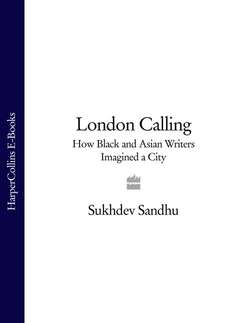London Calling: How Black and Asian Writers Imagined a City

Реклама. ООО «ЛитРес», ИНН: 7719571260.
Оглавление
Sukhdev Sandhu. London Calling: How Black and Asian Writers Imagined a City
London Calling
SUKHDEV SANDHU
Dedication
Contents
Introduction
CHAPTER ONE ‘In Our Grand Metropolis’
CHAPTER TWO Sheer Chandelier
CHAPTER THREE Coasting a Lime on the Serpentine
CHAPTER FOUR Cultural Capital
CHAPTER FIVE Pop Goes the Centre
CHAPTER SIX Digging Our Scene
CHAPTER SEVEN London’s Burning
P.S. Ideas, Interviews & Features … About the Author
Read On
A Conversation with Sukhdev Sandhu
LIFE at a Glance. BORN
EDUCATED
CAREER
You Should Listen to …
You Should Read …
You Should Visit …
Corner of Archer and Rupert Street, Soho, W1
Jamme Masjid, Brick Lane, E1
Internet cafés
Little Britain, EC1
www.derelictlondon.com
Don’s Café, 150 Lower Clapton Street, E5
Vietnamese DVD sellers
New Beacon Bookshop, 76 Stroud Green Road, N4
Leicester Square, W1
Lunar House, Croydon, SE23
You Should Watch …
Afterword
Bibliography
PART ONE
PART TWO
Index
Acknowledgements
About the Author
Notes
Chapter One
Chapter Three
Chapter Four
Chapter Five
Chapter Six
Chapter Seven
Praise
Copyright
About the Publisher
Отрывок из книги
How Black and Asian Writers Imagined a City
Title Page
.....
The majority of Sancho’s extant correspondence stems from this period, a busy one during which he also composed harpsichord pieces, imparted literary advice to writers such as George Cumberland, socialized with the likes of Garrick, Reynolds and Nollekens, and succeeded – albeit with difficulty – in juggling both commerce and connoisseurship. For much of the 1770s, he paid the penalty for his youthful dissolution. Racked by constant stomach pains, he was also frequently gout-ridden, and died on 14 December 1780. Two years later one of his correspondents, Frances Crewe, took advantage of the rising tide of Abolitionism and published as many of his letters as she could track down in a two-volume edition that was also prefaced by a short biography by the Tory MP Joseph Jekyll. The book was a huge success, attracting 1182 subscribers (a number apparently unheard of since the early days of The Spectator) and selling out within months. It raised more than five hundred pounds for his bereaved family and was followed by another four editions over the next two years.
The letters themselves are of variable quality. Many are homiletic and filled with social and religious advice to his correspondents. Others contain literary and art criticism, accounts of illness-torn domestic life at Charles Street, political commentary, descriptions of election hustings and London’s pleasure gardens, requests for financial aid. Some are just business chits, workaday notes dealing with grocery matters, and are accordingly rather dull. Some, too, are clotted with the rhetoric of social decorum: cordiality, cultivation, civility, sincerity and gratitude are the key – and endlessly invoked – virtues. He lauds people excessively and claims they are ‘deservedly honoured, loved, and esteemed’.55 At his best, though Sancho can also be scatological and biting, as well as learned, tender and deeply moving. The letters brim, to an extent unparalleled for almost two centuries, with comedy, familial devotion and an unembarrassed love of London. They also display an obsession with literariness, a quality not especially prized by Equiano or Gronniosaw, or, indeed, those who would value eighteenth-century black English writing for its historical rather than its aesthetic significance.
.....